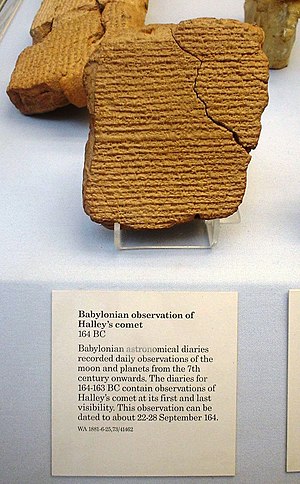Babil astronomisi

Babil astronomisi, Mezopotamya'nın tarihinin ilk dönemlerinde gök cisimlerinin incelenmesi veya kaydedilmesiydi. Kullanılan sayısal sistem olan altmışlık sistem, modern ondalık sistemdeki on sayısının aksine altmışa dayanıyordu. Bu sistem alışılmadık derecede büyük ve küçük sayıların hesaplanmasını ve kaydedilmesini kolaylaştırıyordu.[1]
MÖ 8. ve 7. yüzyıllarda Babil astronomları, gök bilimine yeni bir deneysel yaklaşım geliştirdiler. Evrenin ideal doğasıyla ilgilenen inanç sistemlerini ve felsefelerini, incelemeye ve kaydetmeye; tahmine dayalı gezegen sistemlerinde dâhili bir mantık kullanmaya başladılar. Bu, astronomi ve bilim felsefesine yapılmış dikkate değer bir katkıydı ve bu nedenle bazı modern bilim insanları bu yaklaşımı bilimsel bir devrim olarak adlandırmıştır.[2] Astronomiye yönelik bu yaklaşım Yunan ve Helenistik astrolojide benimsenmiş ve daha da geliştirilmiştir. Klasik Yunan ve Latin kaynakları, astronomi ve diğer divinasyon biçimlerinde uzmanlaşmış rahip-yazıcılar olarak kabul edilen filozoflar için sıklıkla "Keldaniler" terimini kullanmaktadır. Babil astronomisi modern astrolojinin yolunu açmıştır ve Helenistik Dönem olan 2. yüzyılda Yunan-Roma imparatorluğu boyunca yayılmasının sebebidir. Babilliler gezegenlerin geçişlerini izlemek için altmışlık sistemi kullanmış, 360 derecelik gökyüzünü 30 dereceye bölerek ekliptik boyunca yıldızlara 12 burç atamışlardır.
Babil astronomisinden günümüze çoğunlukla astronomi günlükleri, efemerisler ve usul metinleri içeren çağdaş kil tabletlerden oluşan parçalar ulaşmıştır, dolayısıyla Babil gezegen teorisine dair mevcut bilgiler bölük pörçük durumdadır.[3] Bununla birlikte, günümüze ulaşan parçalar Babil astronomisinin “astronomik olayların rafine bir matematiksel tanımını vermeye yönelik ilk başarılı girişim” olduğunu ve “Helenistik dünyada, Hindistan'da, İslam dünyasında ve Batı'da bilimsel astronominin sonraki tüm çeşitlerinin ... temelde kesin olarak Babil astronomisine bağlı olduğunu” göstermektedir.[4]
Ayrıca bakınız
- Babil takvimi
- Babil matematiği
- Babil yıldız katalogları
- Mısır astronomisi
- Astronomi tarihi (Mezopotamya bölümü).
- MUL.APIN
- Ülker takımyıldızı
Kaynakça
Özel
- ^ Friberg 2019.
- ^ Brown 2000, s. 5–6,.
- ^ Aaboe 1958, s. 209.
- ^ Aaboe 1974, s. 21.
Genel
- Aaboe, Asger (1958). "On Babylonian Planetary Theories". Centaurus. 5 (3–4): 209-277. doi:10.1111/j.1600-0498.1958.tb00499.x.
- Aaboe, Asger (1974). "Scientific Astronomy in Antiquity". Philosophical Transactions of the Royal Society of London. Series A, Mathematical and Physical Sciences. 276 (1257): 21-42.
- Aaboe, Asger (2001). Episodes From the Early History of Astronomy. Springer. doi:10.1007/978-1-4613-0109-7. ISBN 978-0-387-95136-2.
- Aaboe, A.; Britton, J.P.; Henderson, J.A.; Neugebauer, O.; Sachs, A.J. (1991). "Saros Cycle Dates and Related Babylonian Astronomical Texts". Transactions of the American Philosophical Society. 81 (6): 1-75. doi:10.2307/1006543.
- Brown, David (2000). Mesopotamian Planetary Astronomy-Astrology. Brill.
- Evans, James (1998). The History and Practice of Ancient Astronomy. Oxford University Press.
- Friberg, Jöran (2019). "Three thousand years of sexagesimal numbers in Mesopotamian mathematical texts". Archive for History of Exact Sciences. 73 (2): 183-216. doi:10.1007/s00407-019-00221-3.
- Hayakawa, Hisashi; Mitsuma, Yasuyuki; Ebihara, Yusuke; Miyake, Fusa (2019). "The Earliest Candidates of Auroral Observations in Assyrian Astrological Reports: Insights on Solar Activity around 660 BCE". The Astrophysical Journal Letters. 884 (1): L18. arXiv:1909.05498 $2. doi:10.3847/2041-8213/ab42e4.
- Hetherington, Norris S. (1993). Cosmology : historical, literary, philosophical, religious, and scientific perspectives. CRC Press.
- Holden, James H. (2006). A History of Horoscopic Astrology. American Federation of Astr.
- Hunger, Hermann; Pingree, David (1999). Astral Sciences in Mesopotamia. Brill.
- Koch, Ulla Susanne (1995). Mesopotamian Astrology: An Introduction to Babylonian and Assyrian Celestial Divination. Museum Tusculanum Press.
- Lambert, W.G. (1987). "Review: Babylonian Astrological Omens and Their Stars". Journal of the American Oriental Society. 107 (1): 93-96.
- Leverington, David (2003). Babylon to Voyager and Beyond: A History of Planetary Astronomy. Cambridge University Press.
- Neugebauer, O. (1948). "The History of Ancient Astronomy Problems and Methods". Journal of Near Eastern Studies. 4 (1): 1-38. doi:10.1086/370729.
- Olmstead, A.T. (1938). "Babylonian Astronomy: Historical Sketch". The American Journal of Semitic Languages and Literatures. 55 (2): 113-129. doi:10.1086/amerjsemilanglit.55.2.3088090.
- Ossendrijver, Mathieu (2016). "Ancient Babylonian astronomers calculated Jupiter's position from the area under a time-velocity graph". Science. 351 (6272): 482-484. doi:10.1126/science.aad8085.
- Pingree, David (1992). "Hellenophilia versus the History of Science". Isis. 83 (4): 554-563. doi:10.1086/356288.
- Pingree, David (1998). "Legacies In Astronomy And Celestial Omens". Dalley, Stephanie (Ed.). The Legacy of Mesopotamia. Oxford University Press. ss. 125-137.
- Rochberg, Francesca (2002). "A consideration of Babylonian astronomy within the historiography of science". Studies in History and Philosophy of Science Part A. 33 (4): 661-684.
- Rochberg, Francesca (2004). The Heavenly Writing: Divination, Horoscopy, and Astronomy in Mesopotamian Culture. Cambridge University Press.
- Rochberg-Halton, F. (1983). "Stellar Distances in Early Babylonian Astronomy: A New Perspective on the Hilprecht Text (HS 229)". Journal of Near Eastern Studies. 43 (3): 209-217.
- Sarton, George (1955). "Chaldaean Astronomy of the Last Three Centuries B. C." Journal of the American Oriental Society. 55 (3): 166-173. doi:10.2307/595168.
- Steele, John (2019). "Explaining Babylonian Astronomy". Isis. 110 (2): 292-295. doi:10.1086/703532.
- Van der Waerden, B.L. (1949). "Babylonian Astronomy. II. The Thirty-Six Stars". Journal of Near Eastern Studies. 8 (1): 6-26. doi:10.1086/370901.
- Van der Waerden, B.L. (1951). "Babylonian Astronomy. III. The Earliest Astronomical Computations". Journal of Near Eastern Studies. 10 (1): 20-34. doi:10.1086/371009.
- Van der Waerden, B.L. (1987). "Babylonian Astronomy. III. The Earliest Astronomical Computations". Annals of the New York Academy of Sciences. 500 (1): 525-545. doi:10.1111/j.1749-6632.1987.tb37224.x.
- Watson, Rita; Horowitz, Wayne (2011). Writing Science Before the Greeks: A Naturalistic Analysis of the Babylonian Astronomical Treatise MUL.APIN. Leiden: Brill Academic Pub. ISBN 978-90-04-20230-6.
Konuyla ilgili yayınlar
- Jones, Alexander. "The Adaptation of Babylonian Methods in Greek Numerical Astronomy." Isis, 82(1991): 441-453; reprinted in Michael Shank, ed. The Scientific Enterprise in Antiquity and the Middle Ages. Chicago: Univ. of Chicago Pr., 2000. 0-226-74951-7ISBN 0-226-74951-7
- Neugebauer, Otto. Astronomical Cuneiform Texts. 3 volumes. London:1956; 2nd edition, New York: Springer, 1983. (Commonly abbreviated as ACT).
- Toomer, G. J. "Hipparchus and Babylonian Astronomy." In A Scientific Humanist: Studies in Memory of Abraham Sachs, ed. Erle Leichty, Maria deJ. Ellis, and Pamela Gerardi, pp. 353–362. Philadelphia: Occasional Publications of the Samuel Noah Kramer Fund 9, 1988.













